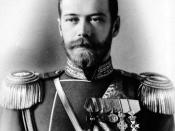Long and short-term causes that contributed to the 1917 Revolution
By early 1917, the existing order in Russia was on the verge of collapse. The spark to the events that ended tsarist rule was ignited on the streets of Petrograd in March 1917. Driven by shortages of food and fuel, crowds of hungry citizens and striking workers began spontaneous rioting and demonstrations. The Rominov dynasty was to end after 304 years, bought down by the March 1917 revolution. There were many long term causes such as the Nicholas personal ruling style, the Russian economy, and general feeling of discontent, but ulitimaly the outbreak of revolution was the caused by Russia entering World War I.
Nicholas was a weak and incompetent ruler. He allowed himself to be influenced by people who did not want any changes to take place in Russia. In Russia there were huge differences between the rich and the poor.
About four-fifths of the population were peasants many of whom could not read or write. In the towns workers were squashed into very poor accommodation. The Tsars autocracy was very badly organized and caused many conflicts between the people and the Russian government. It had been like this for a long time and needed a complete change. The Tsarist system meant that the Tsar had complete power and authority. He was the head of the state and had control over the Russian Orthodox Church. All the important decisions were made in St. Petersburg, without asking the people of Russia what their views were - decisions that were made were announced by thousands of officials and bureaucrats. This angered the people as they felt the Tsar was ignoring them and did not care about their opinions. Nearly 90% of people were peasants and most were poverty stricken. Political parties...


